Au travail suis sans espoir de confort 3v · Loyset Compere
Sources:
*Copenhagen 1848 p. 106 »Au traval suis sans expoir de confort« 3v · Edition · Facsimile
*Florence 2794 ff. 51v-52 »Au travail suis sans espoir de confort« 3v · Edition
Rome 2856 ff. 4v-5 »Au travail suis« 3v Loiset compere · Facsimile
This page with editions as a PDF
Text: Rondeau cinquain, quodlibet; full text in Florence 2794; also in Lille 402, no.22, ed.: Françon 1938, p. 135, and Jardin 1501 with different couplet and tierce, f. 117v.
After Florence 2794:
|
Au travail suis sans espoir de confort, De la servir je feray mon effort, Au travail suis sans espoir de confort, Combien que c’est ung dangereulx deport Au travail suis sans espoir de confort, |
I am in such trouble with no hope of consolation, To serve her I exert my effort, I am in such trouble with no hope of consolation, As much as it is a dangerous venture I am in such trouble with no hope of consolation, |
1) Cop 1848 and Jardin 1501, line 2, “... et vaulx a demy mort”; Lille 402, “... et vaulx que demy mort”.
2) Line 5, the word “cueur” is missing in Florence, and the last word is “fort"; Cop 1848, “malheureulx cueur, certes tu avoyes tort”; Jardin 1501, “malheureux cueur, certes tu auroyes grant tort”; Lille 402, “malheureux cueur, certes tu aurois tort”.
Evaluation of the sources:
This rondeau is made up from quotations of chansons, which all can be found in the “Loire Valley” chansonniers. It was entered into the French chansonnier MS 2794 in Biblioteca Riccardiana, Florence, by the main scribe of the chansonnier. This copyist along with the second scribe in Florence 2794 also added chansons by Fresnau and Compere to the Laborde and Dijon chansonniers, probably during the later years of the 1470s. (1) It was copied without any errors except for a slight misreading of the last line in the poem’s refrain (see above).
It appears without text (only incipits) in the a few years younger North-Italian chansonnier, Rome 2856, with only a few musical variants, and the composer’s name is very clearly given as “Loiset compere”. That the song became widely known is testified by its appearance in the much later French MS from Lyons in the Royal Library of Copenhagen, Ny kgl, Samling 1848 2°. Here it is as part of the collection’s earliest repertory, which was copied just around 1520. It has only the rondeau’s refrain as text in the upper voice, and – considering a temporal distance of about four decades – musically it is surprisingly similar Florence 2794. Copenhagen 1848 contains only a single significant variant, which seems to be a modernization: Bar 14 in its tenor has a semibrevis, a minima-rest and three minimae – all d'; it speeds up and puts a spotlight on the tenor's entrance with “par le regard”.
Comments on text and music:
As it stands on the page, the poem is a courtly love song in rich rimes léonines. But it is not a run-of the-mill sad rondeau. It was created by the composer while he shaped the music as homage to two older masters.
The beginnings of each of the refrain’s five lines quote songs by Ockeghem and Du Fay, songs that were well known in the Loire region – we may safely assume that the first song is by Ockeghem, and not by Barbingant. It is most probable that “Au travail suis sans espoir de confort” was created when Compere in or after 1475 returned from his service in Milan to take up a position in the French court chapel, where Ockeghem was its celebrated leader. Du Fay, the most famous composer of the century, had just died, and Compere had earlier honoured him in his singer’s motet “Omnium bonorum plena”, which builds on the tenor from Hayne van Ghizeghem’s song “De tous biens plaine”. (2) In “Au travail suis” Compere resumed the connection made earlier by letting Hayne’s “De tous biens plaine” continue Du Fay's “Par le regart d’une” and thus complete line three of the poem.
The technique of borrowing to create new music was well known. It forms part of all the music, sacred or secular, which builds on existing tunes or voice-parts extracted from compositions, or that uses parody technique or strings together dissimilar quotes in a quodlibet over a given tenor. Compere’s song is something new. It strings together slices of polyphonic songs as a tribute to revered music masters, and in most cases he quotes or alludes to several voices in the original songs. We find the closest parallel to this procedure in a poem by his friend, the Burgundian court chronicler Jean Molinet. In Molinet’s prayer to the Virgin Oroison a Nostre Dame beginning “Tout a par moy affîn qu’on ne me voye” every stanza quote in their first and last lines songs from the repertory of the ‘Loire Valley’ chansonniers. Molinet used the idea again in the first line of every speech in his irreverent Le debat du viel gendarme et du viel amoureux. (3)
Compere keeps his setting within strict confines: the upper voice moves within an octave (c'-c'') and tenor and contra share a range an octave lower (c-f') – the musical cast is the same as in most of his models. The first and the second sections of the rondeau open with octave imitations between superius and tenor over material by Ockeghem. Else the musical structure is determined by the quotes and Compere’s ingenious continuations.
The opening imitation is lifted from superius and tenor in Ockeghem’s »Au travail suis que peu de gens croiroient« transposed down a tone. Compere’s tenor includes the model’s movement to the octave, and this is taken up by the contra (ex. 1a-b; the colour markings indicate quotes from or allusions to the model’s upper voice (red), tenor (green) or contratenor (blue)).
Ex. 1a Compere, bars 1-3
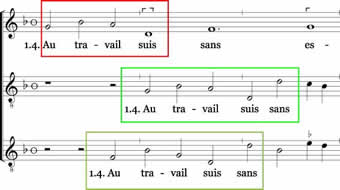
Ex. 1b Ockeghem / Barbingant in Dijon, bars 1-3
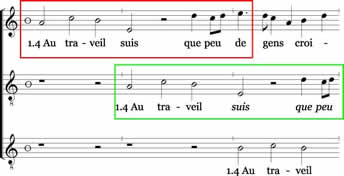
Compere brings the first line to an end with the words “sans espoir de confort”, which might be a quote from a today unknown song. But then in the upper voice only, as the lower voices plunge into the lively drive to the cadence characteristic of a Compere chanson. The second line cites complete the opening line from Ockeghem’s bergerette »Presque transi ung peu moins qu’estre mort«. Musically he quotes more than three bars from the upper voices and three notes from the contratenor, all transposed up a fourth; he makes them his own by lightly rearranging and paraphrasing (ex. 2a-b).
Ex, 2a Compere, bars 8-11
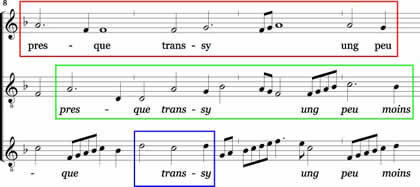
Ex. 2b Ockeghem in Dijon, bars 1-4
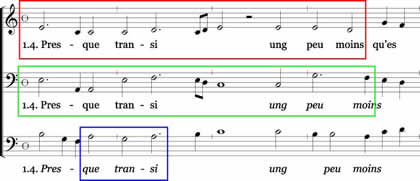
All three voices of the opening of Du Fay’s »Par le regart de vois beaulx yeulx« are quoted in the form in which the song might have been sung as suggested by the MSS Munich 9669 and Sevilla 5-I-43 (Ex. 3a-b; ex. 3b is a reconstruction based on the Wolfenbüttel chansonnier – see further the comments on Du Fay’s song). Compere completes the sentence by citing Hayne van Ghizeghem’s »De tous biens plaine est ma maistresse« (ex. 4a-b); only the highest part is quoted, and in accordance with the relationship between the tempus imperfectum diminutum in Hayne’s song and the triple tempus perfectum in Compere’s the note values has been halved in order to retain its tempo.
Ex. 3a Compere, bars 14-16
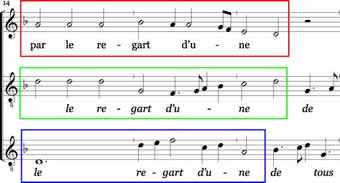
Ex. 3b Du Fay in Wolfenbüttel, bars 1-3
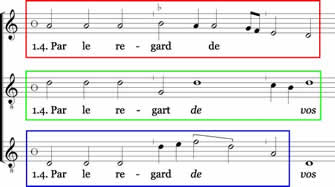
Ex, 4a Compere, bars 17-19
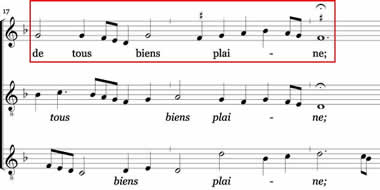
Es. 4b Hayne van Ghizeghem in Dijon, bars 1-5
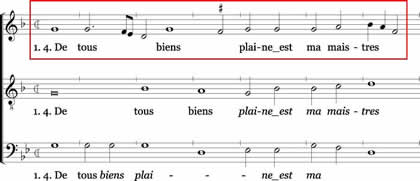
The rondeau’s second section begins with an imitation between tenor and superius based on a free rendering of the tenor opening in Ockeghem’s »D’un autre amer mon cueur abesseroit«; also this one in halved note values, and allusions to snatches of the contratenor and superius may also be perceived (ex. 5a-b).
Ex. 5a Compere, bars 19-23

Ex. 5b Ockeghem in Laborde, bars 1-8
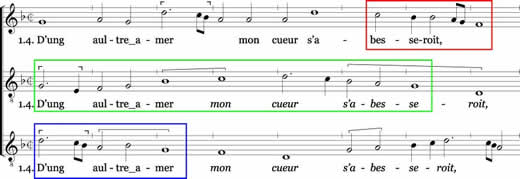
The last quote is also quite free. It hints at the first words in Du Fay’s »Malheureux cueur que veulx tu faire« transposed up a tone (Ex. 6a-b).
Ex. 6a Compere, bars 24-26
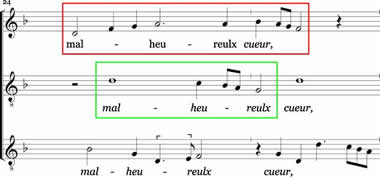
Ex. 6b Du Fay in Laborde, bars 1-2

The free continuations in lines 1, 4 and 5 all include in the superius, whether they contain further unknown quotes or not, an upward leap of a fourth g'-c'' (bb. 5, 22 and 29), which activates the rush towards the cadence. Along with the lively lower voices this grants the setting a sense of unity in style and elegance in expression in spite of the diverse models.
PWCH December 2021
1) See further my article ‘The French musical manuscript in Florence, Biblioteca Riccardiana, Ms. 2794, and the ‘Loire Valley’ chansonniers’.
2) Cf. Joshua Rifkin: ‘Compere, “Des Pres”, and the Choirmasters of Cambrai: Omnium bonorum plena Reconsidered’, Acta Musicologica LXXXI (2009), pp. 55-73.
3) Published in Jean Molinet, Les faictz et dictz de Jean Molinet publié par Noël Dupire. Tome II, Paris 1937, pp. 468 and 616.